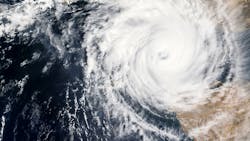Hurricane recovery: Water's essential, overlooked role
Hurricanes like Harvey, Irma and Maria transform our familiar American landscapes into places where people’s homes, jobs—everything they know—simply aren’t there anymore.
And then? Then Americans get busy helping.
Whether it’s churches, synagogues or mosques transforming overnight into evacuation shelters, or millions of people clicking on a link to send instant relief funds, Americans’ response to disaster embodies every noble thing ever said about our country.
That immediate relief is usually summarized as “food, clothing and shelter.” Often overlooked? The role water plays in disaster recovery.
Post-disaster water, by the numbers
Humans cannot survive without water. In addition to feeding, clothing and sheltering people who have been driven from their homes, relief agencies must make sure they have fresh water to drink.
How much water is needed for evacuees after a disaster like Harvey?
At the bare minimum, the Centers for Disease Control and Prevention recommends one gallon per person, per day. With FEMA housing more than 32,000 people in Texas, that’s more than five tanker trucks every day. The needs in Florida will likely be just as serious.
And that’s just for drinking.
People need to bathe and flush toilets, too. Add in basic hygiene, quick showers and moderate toilet use, and shelters need to provide about 30 gallons a day per person. Multiplied by 32,000 people, that’s close to a million gallons a day.
Post-disaster water delivery
Cities like Houston, Jacksonville and their surrounding communities routinely deliver far more than one million gallons a day—during normal times. But these are not normal times.
Electricity is unavailable in many areas, so pumping stations can’t operate. Many freshwater sources are flooded with contaminated runoff that may require extra treatment before delivery. And many of the people who work for water utilities are unable to get to work because of flooded roads—or may themselves be housed in shelters.
If they’re fortunate, communities can get water to everyone who needs it, despite the strains on the system.
If they’re less fortunate, they need help—like the $10,000 in boxed water donated by Sloan.
If they’re truly unfortunate, they will lose water service entirely. That’s what happened in Beaumont, Texas, where 118,000 residents were without water for the better part of a week. That meant that every day, 3.5 million gallons of water had to come from somewhere else.
Sustainability for the short term
At Sloan, we take water sustainability very seriously, because we believe water is the world’s most valuable resource. Not to sound dire, but learning to conserve water may be essential to the long-term health of civilization.
Sustainability has short-term benefits, too. When a disaster strains public water delivery systems, inefficient usage makes the situation worse.
Efficient water use, on the other hand, makes water more available for disaster relief and recovery. The water you save today with Sloan’s water-saving commercial bathroom fixtures can help make sure people get the water they need tomorrow—when everything else in their lives has been taken away.
Sloan has made a donation of $10,000 to the MCAA’s Disaster Relief Fund, as well as a donation of $10,000 worth of boxed water. Please consider helping those in need by visiting the Hurricane Relief page of the American Red Cross.
For more, visit the Sloan Blog at https://www.sloan.com/blog/recovery-harvey-and-irma-water-s-essential-role.
